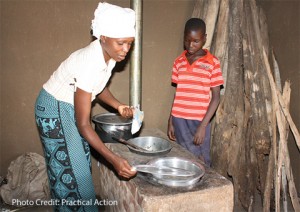Three Steps to Stop Kitchen Smoke from Killing More Women and Children | Source: S. VIJAY IYER, World Bank, Apr 3, 2013 |
I’m back from the 2013 Clean Cooking Forum in Phnom Penh, and impressed with the insights shared by practitioners and household fuel experts from around the world. It’s good to see clean cooking at the center of the global development agenda. But to live up to expectations, we’ll need to keep working hard.
Growing up in the 1960s in a household of modest means in India, I saw my mother’s acute distress as she cooked our meals on the floor of our small kitchen — using sawdust, charcoal or wood. She suffered from chronic respiratory illness and died well before her time. Today, 2.8 billion people, mostly women, still cook as my mother did, using traditional stoves and fuels. We have to change that reality. With such tremendous attention on clean cooking, what can we do to ensure a future where women (and children) do not die because they cook meals for their families?
A lot is happening in this space. The passion and commitment of entrepreneurs, government agencies and non-government actors at the Forum was inspiring. We are making steady progress, but the challenge is huge and we need to get on a steeper results curve. I suggested that we need “accelerators” for faster results. These accelerators, or “game changers”, are actions we can take to address the most critical barriers and drastically shift from business-as-usual. 
Three such accelerators emerged as really important ones in the discussions during the conference:
1) Coordinate multiple sectors and government bodies to create enabling conditions for clean cooking interventions at the national, city and local levels.
2) Bridge the gap between those seeking finance and those able to provide it– foundations and non-government agencies, local financial institutions and equity investors. Often, we need to bundle smaller projects to remove obstacles such as transaction costs and lack of access to willing financiers. This is also true for gaining access to carbon finance opportunities in this sector, often too small and dispersed to interest carbon credit buyers.
3) Create a body of knowledge, best practice and market information that is available as a public good to potential entrepreneurs and market makers, and that helps reduce barriers to their entry. In this area, the UN Practitioners Network, the Global Alliance for Clean Cookstoves and the Sustainable Energy for All Initiative can play important roles.
The World Bank’s recent report One Goal, Two Paths: Achieving Universal Access to Modern Energy in East Asia and the Pacific illustrates how some of these accelerators have transformed the path to universal modern cooking solutions in East Asia Pacific (EAP) countries such as China, Indonesia, Thailand, Cambodia, the Philippines, and Vietnam.
What do you think of when you hear— China, Thailand, Cambodia and Indonesia? Fastest economic growth in the last decade? True. But did you know that half of the East Asia/Pacific countries’ population—one billion people—still relies on solid fuels for cooking and heating? This causes over 600,000 premature deaths each year in the region.
A persistent challenge, as I mentioned in my previous blog post, is that clean cooking remains a “poor person’s problem.” Few business people see a viable market in it. So selling affordable clean cooking fuels (natural gas, liquefied petroleum gas, and biogas) and improved cookstoves needs a financing accelerator.
The One Goal, Two Paths report reviews experience in the EAP countries, and recommends collaborative action by governments, donors, the private sector and NGOs. The report’s suggested “path” has the EAP countries achieving the Sustainable Energy for All objective of universal access to modern cooking solutions by 2030.
The agenda of the “path”:
- Promote clean and efficient cookstoves by making these affordable and profitable
China’s National Improved Stoves Program, a government initiative, distributed over 100 million stoves country-wide. Cambodia’s NGO-led program trained traditional stove makers to produce improved stoves and integrated them into the supply chain. One million improved stoves with guaranteed service and quality were sold in Cambodia from 2003 to 2010.
- Expand liquefied petroleum gas (LPG) usageLPG is a clean, affordable household fuel, and especially efficient in densely populated settings. Policies that encourage faster adoption of LPG are recommended. By granting privileges to LPG suppliers/distributors and keeping LPG’s price low, Thailand’s LPG promotion program has boosted LPG use by 10% a year since 1990.
- Develop biogas energy systems
Biogas energy systems that transform biomass into clean burning gas for cooking have huge potential. China has about 25 million biogas systems in place following its National Rural Biogas Program. Complementing China’s national program, the World Bank recently financed an Eco-farming Project that installed 33,000 biogas digesters in households. These digesters generate gas from animal waste.
The Bank Group’s East Asia and Pacific Clean Stoves Initiative, introduced at the Clean Cooking Forum, provides policy support, capacity building, and knowledge sharing for China, Indonesia, Mongolia, and Laos PDR. It has already published several important studies.
With concerted action and knowledge of the game changers, EAP countries’ household clean energy access could soon match their outstanding economic performance. I’m convinced that the world can learn from their experience and work together. Then, we’ll make real, large-scale differences in the lives of the two-fifths of humanity still tied to traditional stoves and fuels.
Related Studies from East Asia Pacific Clean Stoves Initiative



